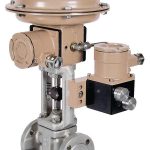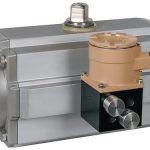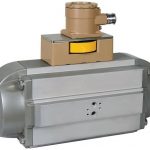High reliability and a low power consumption are not contradictory where Samsomatic solenoid valves and limit switches are concerned. These instruments, with their flameproof enclosure, extend the proven product range and can be used in process automation applications under extreme environmental conditions.
Author Gerald Fiedler Public Relations, Samsomatic
Product properties such as corrosion resistance, a high degree of protection and wide temperature ranges are typical of devices used in extreme ambient conditions. The European Directive 94/9/EC (Atex 100a) describes fundamental safety specifications for the design of explosion-proof devices. A notified body must issue an EC type examination certificate to verify that each device meets these safety requirements. Moreover, Samsomatic places stringent quality demands on all its products, for example to ensure that they function reliably even after they have remained static for long periods of time.
Solenoid valves and limit switches with the “flameproof enclosure” type of protection (II 2G Ex d and II 2D Ex td) are suitable for use in hazardous areas with explosive gas or dust atmosphere. In compliance with the temperature class and the components installed, these devices can be used at ambient temperatures between -45 and +80 °C. The rugged, corrosion-resistant housings made of powder-coated or anodised aluminium or stainless steel are designed to prevent the ingress of dust or powerful jets of water. As a result, all certified enclosures meet the requirements for IP 66 protection (EN 60529).
The devices can be mounted to rotary actuators with a Namur interface (VDI/VDE 3845) or linear actuators with Namur ribs (IEC 60534-6-1) either directly or using customised mounting kits.
Solenoid valves
Type 3966 solenoid valves consist of an electropneumatic binary converter with a flapper/nozzle system and a booster valve with a return spring. This proven-in-use combination of a low-power, electropneumatic binary converter and booster valve (published in cpp 2/2013) has decisive benefits for users: reliable switching even after remaining static for long periods of time, switching behaviour independent of the mounting position, low power consumption for control over fieldbus networks and a wide ambient temperature range. DC voltage signals of 6, 12 or 24 V (other voltage signals on request) are permitted for controlling the electropneumatic binary converter.
The booster valve is a 3/2-way valve that can be configured with either a normally closed or a normally open function. Treated compressed air (ISO 8573-) or nitrogen is used as the operating medium. The supply air for the electro-pneumatic binary converter is connected internally via the supply air port of actuators for on/off service or externally via a separate port when mounted to throttling actuators or positioners. The air routing can be changed without any problems by turning an easily accessible gasket. A pressure reducer reduces the supply air pressure to 1.4 bar.
In the idle position, the flapper is lifted off the outlet nozzle by a spring. As a result, a pressure lower than the activation pressure of the booster valve builds up in the pressure divider, which consists of the restrictor and the outlet nozzle. The supply air flows through the open outlet nozzle and purges the electronics compartment. The slight positive pressure prevents moisture from entering the device and thus inhibits corrosion.
When the solenoid coil is energised by an electric binary signal, the outlet nozzle is closed by the flapper against the force of the spring. This causes the pressure in the pressure divider to rise above the activation pressure of the booster valve and be switched to the operating position. The supply air then flows through the connection to the output port, operating the actuator.
When the solenoid coil is de-energised, the booster valve is switched back to the idle position by a return spring and the output port is closed.
Limit switches
Limit switches issue an electric binary signal when the valve travel exceeds or falls below an adjusted limit. The signal is suitable for switching control signals, issuing visual and audible alarms or connecting to central control or alarm systems.
The type 4747 limit switch is equipped with two inductive proximity switches or two me-chanical microswitches with silver or gold contacts. For most applications these contacts are set to issue a signal when the actuator reaches one of its end positions. The switching point can also be adjusted to any position within the rotational angle or travel range to indicate intermediate positions. To make this easier in hard-to-access installation locations, the limit contacts can be set to the required switching point simply and accurately with a screwdriver.
The shaft of the limit switch is connected to the actuator by a lever. For devices with inductive proximity switches, this shaft has adjustable metal tags. If the tag is inside the magnetic field of the proximity switch, the switch is damped and the output has high impedance (“contact open” switching function). If the tag leaves the magnetic field, the proximity switch is undamped and the output has low impedance (“contact closed” function). On devices with electric microswitches, the shaft has adjustable cam disks. The cam disk operates the microswitch by means of a roller on the switch lever. The double-throw contact of the microswitch can be used as a make or break contact, depending on the required switching function.
cpp-net.com/0114446
Share:









